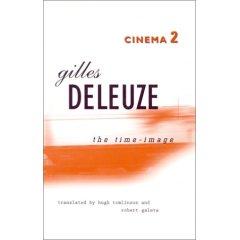Tuesday, July 12, 2005
Neo-realsim and fiction.
So John Weir and I are at the St. Mark's bookshop last night. John's asked that I buy him a copy of Take Me Out, a play about baseball and men who are attracted to men (sorry, but I don't like to use catagorical words for sexuality). I've never seen it, but John's taking an acting class and needs a monologue for this week. It has a good one, but I caution him- it's a monolgue to the audience, and those are always hard because, what do you want from the audience? And the monologue has to move, has to have an emotional through line, like a short-short story. And this one was hard to see. (And I write this, I think later, maybe because I wonder want I want from my audience in this monolgue of a blog).
So then we pick up a Gilles Deleuze title: Cinema 2, which is an analysis of image theory and I'm interested, because it's all about neo-realism. I love neo-realism, though I'm haven't seen too many titles. I've just started watching these Fellini flicks: 8 1/2, La Strada, Amacord, La Dolce Vita... And as I soon as I started to track the connections between the loosely tied plots; the dream-like camera panning; the serial, episodic nature of the narrative:
Vita... And as I soon as I started to track the connections between the loosely tied plots; the dream-like camera panning; the serial, episodic nature of the narrative:
I knew I wanted to write novels like Fellini films.
We read one page. It took 20 minutes to decipher. Deleuze! God! Well, one point, was that "realism"- like Hitchockian films, puts the viewer (or reader) into the story. You became a character. Neo-realism, does the opposite (this was only one point of many, and I don't intend this as a defintion, just one characteristic). It takes the main character and makes him the viewer. I think of Nights of Calabria , or 8 1/2, where the main character drifts from scene to scene, which are either like dreams or are dreams. The surrounding images are so intense that the character is overwhelmed by them, and wanders through them, recording what they see.
How does Fellini make this work? In a narrative, first person, or close third, your character must have a want. I've heard this enough in workshops. "Yes, but what does this character want?" But here we have entire films without ever needing to know what the character wants, or why they move form scene to scene. I think this works because the focus has changed. The main character is no longer the main character, but instead the film itself becomes the main character. The film, the movement from one scene to the next, the invisible emotional connection from scene to scene that tells the story of the movie.
It's this movement that Deleuze says is the "present," the object of focus in the story.
So I'm trying to figure out how to translate this into fiction. If you break down a Fellini film, scene by scene, and study the emotional narrative of each segment, it starts to create a picture. Surely, Catholism, class, and loneliness are constants.
But partly this is an excuse for me to watch more movies and not feel guilty about not reading or writing instead.
So then we pick up a Gilles Deleuze title: Cinema 2, which is an analysis of image theory and I'm interested, because it's all about neo-realism. I love neo-realism, though I'm haven't seen too many titles. I've just started watching these Fellini flicks: 8 1/2, La Strada, Amacord, La Dolce
 Vita... And as I soon as I started to track the connections between the loosely tied plots; the dream-like camera panning; the serial, episodic nature of the narrative:
Vita... And as I soon as I started to track the connections between the loosely tied plots; the dream-like camera panning; the serial, episodic nature of the narrative:I knew I wanted to write novels like Fellini films.
We read one page. It took 20 minutes to decipher. Deleuze! God! Well, one point, was that "realism"- like Hitchockian films, puts the viewer (or reader) into the story. You became a character. Neo-realism, does the opposite (this was only one point of many, and I don't intend this as a defintion, just one characteristic). It takes the main character and makes him the viewer. I think of Nights of Calabria , or 8 1/2, where the main character drifts from scene to scene, which are either like dreams or are dreams. The surrounding images are so intense that the character is overwhelmed by them, and wanders through them, recording what they see.
How does Fellini make this work? In a narrative, first person, or close third, your character must have a want. I've heard this enough in workshops. "Yes, but what does this character want?" But here we have entire films without ever needing to know what the character wants, or why they move form scene to scene. I think this works because the focus has changed. The main character is no longer the main character, but instead the film itself becomes the main character. The film, the movement from one scene to the next, the invisible emotional connection from scene to scene that tells the story of the movie.
It's this movement that Deleuze says is the "present," the object of focus in the story.
So I'm trying to figure out how to translate this into fiction. If you break down a Fellini film, scene by scene, and study the emotional narrative of each segment, it starts to create a picture. Surely, Catholism, class, and loneliness are constants.
But partly this is an excuse for me to watch more movies and not feel guilty about not reading or writing instead.


